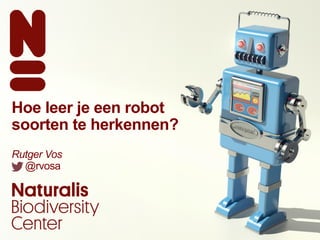
Hoe leer je een robot soorten te herkennen?
- 1. Hoe leer je een robot soorten te herkennen? Rutger Vos @rvosa
- 2. Experts van Naturalis kunnen heel veel soorten herkennen, maar dat kost veel tijd. Kunnen we robots leren hoe je dat (in simpele gevallen) doet?
- 3. Wat hebben we nodig? • Goede voorbeeldfoto’s van soorten • Automatische beeldbewerking • Onderscheidende kenmerken die uit foto’s gehaald kunnen worden • Robothersenen (“kunstmatige intelligentie”) • Een handige “app” om mee te werken
- 4. Voorbeeldfoto’s “Vrouwenschoentjes” zijn een groep orchideeën met mooie bloemen. Bovendien smaken de knollen lekker: in Turkije en Griekenland worden er drankjes en roomijs van gemaakt. De Vrouwenschoentjes zijn daarom bedreigd in het wild, en de handel is aan banden gelegd. Het is dus belangrijk dat de douane ze goed kan herkennen.
- 5. photos [table] id INTEGER NOT NULL md5sum VARCHAR(32) NOT NULL path VARCHAR(255) title VARCHAR(100) description VARCHAR(255) photos_tags [table] photo_id INTEGER NOT NULL tag_id INTEGER NOT NULL tags [table] id INTEGER NOT NULL name VARCHAR(50) NOT NULL photos_taxa [table] photo_id INTEGER NOT NULL taxon_id INTEGER NOT NULL taxa [table] id INTEGER NOT NULL rank_id INTEGER NOT NULL name VARCHAR(50) NOT NULL description VARCHAR(255) ranks [table] id INTEGER NOT NULL name VARCHAR(50) NOT NULL Onze database van voorbeeldfoto’s We gebruiken Flickr om samen onze database bij te kunnen houden. Met trefwoorden bij elke foto geven we aan tot welke soort (en geslacht, en familie, enz.) de bloem in de foto behoort.
- 6. Foto’s automatisch voorbewerken b)a) Wij kunnen zien waar de bloem zit in de foto en kunnen de rest negeren. Een computer kan dat niet, dus je moet alles wat niet belangrijk is weghalen.
- 7. Wat is een “pixel”? b)a) Een pixel mengt drie kleuren, uitgedrukt in getallen: • Rood (114/255) • Groen (110/255) • Blauw (33/255)Een digitale foto bestaat uit duizenden “pixels”
- 8. Kenmerken waar een robot iets mee kan Horizontal bin MeanColourIntensity 050100150200250 Vertical bin MeanColourIntensity 050100150200250 Een robot ziet geen bloem. Een robot kan alleen iets met getallen. We moeten de bloem dus omzetten in getallen die kenmerkend zijn voor de soort. We doen dat door de foto in 50 horizontale en 50 verticale “plakjes” te snijden en voor elke plakje het gemiddelde van de pixelwaardes (R,G,B) te nemen.
- 10. Soortherkenning door neurale netwerken Horizontalbin MeanColourIntensity 05010015020 MeanColourIntensity 05010015020 Waarneming Nadenken Beslissing Cypripedium wardii Cypripedium tibeticum
- 11. De “app” We hebben een website ontwikkeld waarmee je op een makkelijke manier gebruik kan maken van dit systeem, zowel op de computer als op je telefoon. We noemen het OrchID Zo ziet het er uit:
- 16. Hoe past het allemaal in elkaar? a) Reference image management b) Image analysis and ANN training c) Out-of-sample classification Training photos Cloud storeAnnotate Local file store Local metadata store Extract features Generate code-words Training data ANNsEvolutionary optimization Pre-process Classification Query data Query photo OrchID web application AI::FANN::Evolving NBClassify ImgPheno Flickr API Participating modules Om flexibel te kunnen ontwikkelen is dit project opgebouwd uit onaf- hankelijke modules: • Bijhouden van voorbeeldfoto’s • Foto’s automatisch voorbewerken • Beheren van de robots • Evolueren van robots • Classificatie van onbekende foto’s Dit project is “open source”, geschreven in Python, en beschikbaar op github.com/ naturalis
- 17. Wat moet er nog gebeuren? • We willen dit systeem testen op andere groepen. Als eerste gaan we dit doen voor Javaanse vlinders. • Waarschijnlijk moeten we dan andere kenmerken ontwikkelen, bijvoorbeeld om stippen te herkennen. • We willen een app maken die ook echt in de app store voor iPhones en Androids te vinden is. Vlinders uit de collectie Van Groenendael. Verzameld in de jaren ‘30 in Java (toen dus in “Nederlands-Indië”). Hier hebben we er heel veel van.
- 18. Doe je mee? Je kan je stage doen bij Naturalis: rutger.vos@naturalis.nl Ons team Patrick Wijntjes maakte de app Serrano Pereira deed het rekenwerk Barbara Gravendeel weet alles van orchideeën Meedenkers: • Thibaut De Meulemeester • Leni Duistermaat • Arjan Gittenberger • David Heijkamp • Youri Lammers • Peter van Welzen
- 19. Bedankt voor jullie aandacht! Contact: rutger.vos@naturalis.nl @rvosa (twitter)
